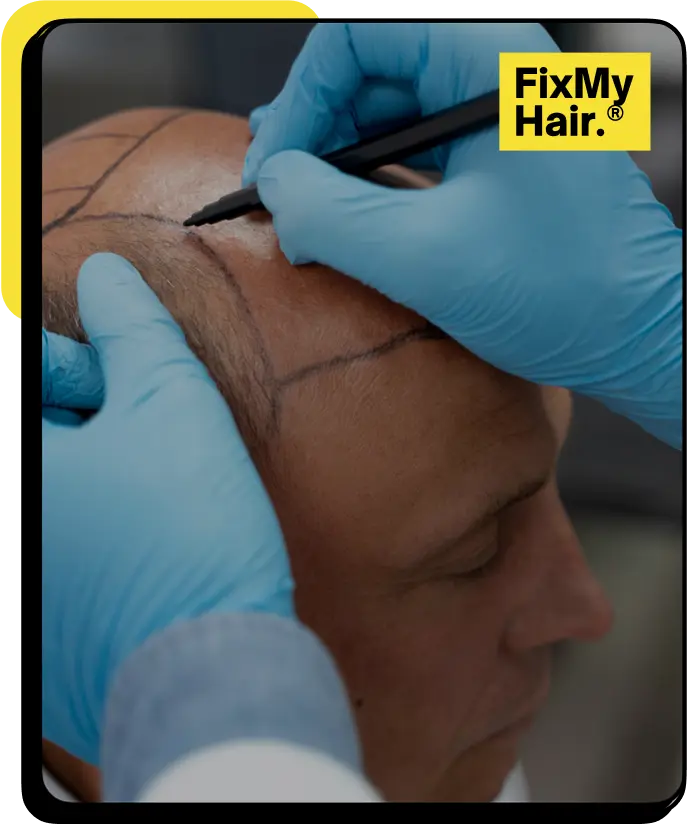FUE vs FUT: Which Hair Transplant Is Right for You?

Millions of Britons experience hair loss, making hair restoration a booming market In the UK, two surgical techniques dominate: Follicular Unit Extraction (FUE) and Follicular Unit Transplantation (FUT). Both transplant healthy hair follicles (usually from the back of the scalp) to thinning areas, yielding permanent results. However, they differ in method, cost, recovery, and suitability. This post compares FUE hair transplant vs FUT hair transplant – including procedure details, success rates, UK costs, patient satisfaction, recovery times, and regional trends – to help you choose the right option.
What Are FUE and FUT Hair Transplants?
- FUE (Follicular Unit Extraction) is a minimally invasive hair restoration technique. The surgeon administers local anaesthetic, shaves (or trims) the donor area, then uses a tiny punch tool (typically 0.75–0.9 mm) to remove individual follicle grafts one by one. Each graft is stored and then implanted into the balding area. Because follicles are extracted individually, FUE leaves many tiny dot scars across the donor site (usually hidden under hair). A typical extraction rate is ~750–1,000 grafts per hour. If you’re considering FUE hair treatment in the UK, book a consultation with our FUE hair treatment specialist today.
- FUT (Follicular Unit Transplantation) – also called the “strip method” – involves cutting a long, narrow strip of scalp (about 1–1.5 cm wide and 10–15 cm long) from the donor area. Technicians then microscopically dissect this strip into individual grafts, while the surgeon sutures the wound closed. This yields a linear scar across the back of the head. FUT is efficient for large sessions: one session can yield 2,000–4,000 grafts. To explore FUT hair transplant options in the UK, schedule a consultation with our FUT hair transplant expert.
Each method has its steps and subtleties, but in broad terms: FUE extracts single hairs (little wounds, quicker healing), while FUT removes a strip (more invasive, one scar, potentially more grafts). Both require skilled surgeons to ensure graft survival and natural results.
Key Differences Between FUE and FUT
Clinics and experts highlight the main trade-offs between FUE and FUT. The table below summarizes major features:
Feature | FUE | FUT |
Extraction Method | Individual follicles using a small punch tool | A strip of scalp excised, then dissected |
Grafts per Session | ~750–1,000 per hour | ~2,000–4,000 total |
Scarring | Tiny dot scars (often imperceptible) | One linear scar at donor site |
Recovery Time | Faster – most resume light activities in ~2 weeks | Slower – up to ~1 month before full healing |
Procedure Length | Typically 6–9 hours (slower graft harvesting) | Often shorter (strip excision + dissection occur simultaneously) |
Pain & Discomfort | Generally mild (no sutures) | Moderate (sutures, higher tension) |
Cost per Graft | ~£2.10–£5.60 in the UK | ~£2.50–£6.30 in the UK |
Ideal For | Men wanting short hair styles, minimal scarring; smaller sessions | Patients needing many grafts, or who prefer not to shave donor area (e.g. long-haired patients) |
Below, we elaborate on these differences and what they mean for you:
- Harvest and Graft Yield: FUT can harvest a larger volume in one session – up to 4,000 grafts in a day – making it efficient for extensive hair loss. FUE harvests fewer per session (~750–1,000 per hour) and may require multiple sessions for very large transplants.
- Scarring: FUE leaves many tiny puncture scars that are rarely visible when hair regrows. FUT leaves one longer scar. If you keep hair very short at the back, FUT’s scar may be seen, whereas FUE’s dot scars usually remain hidden even with a short cut.
- Recovery: FUE’s tiny wounds heal faster. Patients often return to normal routines within about 7–14 days. FUT involves a larger wound and stitches, so full recovery can take longer – often up to a month before you feel fully normal. For example, light exercise may resume in ~2 weeks after FUE vs ~4 weeks after FUT.
- Pain & Sensation: With FUT, the donor strip and sutures often cause more discomfort or numbness (pain scale ~4–6) than FUE (pain scale ~2–4). Many clinics report that FUE patients experience milder pain and tension post-op, whereas FUT patients may have more soreness at the incision site.
- Procedure Duration: FUE procedures tend to take longer (all grafts extracted individually) – often 6–9 hours or more. FUT can be faster overall because while part of the team dissects grafts under the microscope, the surgeon is already preparing the recipient sites.
- Cost: In the UK, FUE usually costs slightly more per graft due to the labour-intensive nature. Typical cost per graft in UK clinics is about £2.10–5.60 for FUE and £2.50–6.30 for FUT. In practice, the total cost depends on graft count; clinics report an average of ~1,610 grafts for a standard case. At ~£4,820 total average cost, that’s roughly £3 per graft. (Prices vary by clinic and region.)

Success Rates and Patient Satisfaction
Both FUE and FUT can achieve excellent, natural-looking results when done by experienced surgeons. Studies report high graft survival rates for both methods. Clinic data indicate survival of about 90–96% of grafts for each technique For example, one study found over 90% of transplanted FUE follicles survived, and most patients had ≥95% of follicles survive by 12 months Another source notes FUT may offer a “slightly higher” survival due to less handling trauma to each follicle, but well-performed FUE can match those results.
Importantly, patient satisfaction is very high for both. The vast majority of people get strong, long-lasting improvement. According to a 2024 BMC Surgery study, FUE patients reported satisfaction over 98% In clinic surveys, roughly 93% of FUE patients and 87% of FUT patients were very satisfied with their results. In other words, most patients get the desired outcome and a natural look. Overall, hair transplant success rates (across all methods) are typically cited above 97% meaning grafts survive and grow in nearly all cases.
Beyond survival, patients notice cosmetic differences: FUE patients often praise the minimal scarring and quick healing, while FUT patients appreciate that large sessions can restore more hair in one go Both achieve permanent results, as transplanted hairs come from DHT-resistant zones on the scalp.
Recovery and Aftercare
Recovery plans differ slightly for FUE vs FUT:
- FUE Recovery: Because there are no stitches, FUE wounds heal quickly. Light activities (like desk work) can usually resume within a few days, and most patients feel comfortable within about two weeks. You may see some redness or scabbing at extraction sites that resolves within 10–14 days. Mild swelling around the forehead can occur for 2–5 days. Pain is generally mild and managed with over-the-counter meds. Surgeons advise gentle head-washing after 24–48 hours and avoiding strenuous exercise for 1–2 weeks.
- FUT Recovery: With FUT, you’ll have sutures or staples closing the donor area. These are usually removed after 10–14 days. Because of the larger wound, expect slightly longer healing: light exercise might wait up to a month, versus ~2 weeks for FUE. Dressings and stitches require some care. Patients often feel more tightness and numbness in the donor scalp for weeks (often resolving in 2–4 weeks). However, both FUE and FUT typically yield similar final results by 12 months, and swelling timelines (2–5 days) are alike for both techniques.
In all cases, strict aftercare helps success. Follow your surgeon’s advice on washing, medications (e.g. antibiotics, anti-inflammatories), and sleep position. Complications are rare (<6% overall) if guidelines are followed. Most patients only experience temporary “shock loss” of old hairs, which regrow fully. True graft failure is usually low (often reported 2–10%), so adherence to aftercare is key for survival.
Cost Considerations in the UK
Hair transplant cost in the UK varies widely. On average, a UK hair transplant is about £4,820. However, depending on your hair loss stage and clinic, quotes ranged from around £2,000 to £15,000 for the same case in one survey. Key factors include the number of grafts needed, surgeon skill, location, and clinic reputation.
- Average Pricing: Wimpole Clinic’s 2024 survey found an average cost of £4,820 for a Norwood 2–3 case. They asked 104 clinics for quotes on the same patient photos: the lowest quote was ~£1,995 and the highest ~£15,000. This huge range shows why researching multiple clinics is vital. Typically, more grafts → higher total cost, but cost per graft often decreases for larger procedures.
- Cost per Graft: Many clinics price by the graft. Typical FUE grafts in the UK cost roughly £2.10–£5.60 each, while FUT grafts cost about £2.50–£6.30. In practice, £3–£4 per graft is a common ballpark figure. Given the average procedure involved ~1,610 grafts, the £4,820 means works out to roughly £3 per graft.
- Regional Variations: Location matters. London (especially Harley Street) tends to command higher prices. In one analysis, 39% of clinics surveyed were in London (26% on Harley Street), and prices there are slightly elevated. By contrast, clinics outside London (e.g. Manchester, Nottingham) may charge somewhat less for comparable results. For instance, Nottingham’s hair transplant clinic advertises £3,000–£7,000 for a transplant (depending on technique and area). Manchester clinics vary but often match London fees due to high demand. (Special offers and package deals can also affect final price.)
- Financing and Consults: Many UK clinics (about 87%) offer a free initial consultation. You can use these to compare options at no cost. Some clinics also provide payment plans or financing for the total fee. Always verify what the quote includes (e.g. post-op meds, aftercare).
In summary: FUE tends to cost a bit more in total because it is more labour-intensive. A full FUE session might run between £6,000–£10,000+, whereas an equivalent FUT might be a few hundred pounds cheaper, depending on grafts. But costs overlap heavily. Always get detailed quotes and confirm they cover everything you need.



Success Rates and Patient Satisfaction
Both FUE and FUT have excellent success rates. Industry-wide, hair transplant survival is very high: over 97% success rate is typical. This means the vast majority of transplanted grafts take hold and grow new hair. As noted, clinic reports and studies find graft survival usually above 90% for both techniques.
Patient satisfaction is also high. According to ISHRS surveys, hair transplant recipients (mostly men) get results they value – 97% of patients are generally satisfied. In our context, one study of 158 Chinese patients reported >98% patient satisfaction after FUE. Another UK clinic’s survey found 93% of FUE patients and 87% of FUT patients rated their outcome as very good. These numbers reflect both the efficacy of modern techniques and improved patient education on realistic expectations.
Ultimately, FUE vs FUT doesn’t change the permanent nature of results. Both methods provide natural hair that grows for life (since donor hairs are DHT-resistant). The main differences lie in scarring and recovery (as above), not in “will it work.” If you follow pre-op advice (e.g. stopping certain meds) and post-op care diligently, you can expect a high density and success rate from either procedure.
Recovery Times and Aftercare
- FUE: Most people can wash their scalp gently after 1–2 days. Small crusts at graft sites fall off in ~10 days. You can often return to a sedentary job in about 1 week and resume exercise (jogging, gym) after ~2 weeks. Swelling or redness is mild.
- FUT: Dressings come off in a few days, but you’ll keep stitches for ~10–14 days. Light work is possible after 1–2 weeks, but activities stressing the back of the head (like vigorous exercise) may need to wait ~1 month. The linear wound will feel tight; avoid lifting heavy objects for a few weeks. Some numbness around the scar is common, usually temporary.
Recovery timelines differ slightly:
In both cases, the transplanted hairs typically shed in the first 2 months (a normal “shock loss”) and regrow over 6–12 months. Final fullness is usually seen after one year. Make sure to take any prescribed medications (antibiotics, anti-inflammatory, hair-growth meds) and follow your surgeon’s hair-washing schedule closely. According to one UK analysis, not following aftercare is linked to poorer results.
Popularity Trends in the UK
Hair transplant demand has surged in recent years. In the UK, procedures have increased roughly 40% over the past five years, with about 30,000 people seeking treatment (private and NHS combined). Globally, Europe saw a 240% increase in procedures from 2010 to 2021. Men (87% of patients) are far more likely than women to have surgery, though female transplants are also growing. Younger generations (men in their 20s–30s, women in their 30s–40s) are now the most common age groups.
Within the UK, major cities host the busiest clinics. London is a primary hub: surveys show 39% hair of clinics are in London (26% on Harley Street), where demand and prices are high.
Manchester has also become known as a “medical hub” for hair transplants, reflecting high local demand.
Clinics in Glasgow, Birmingham, Nottingham and Liverpool likewise attract many clients. For example, Nottingham clinics note procedures costing £3–7K, while Liverpool’s famed Royal Liver Building even houses a transplant clinic. Across these cities, both FUE and FUT are offered; urban patients often choose FUE for its quick recovery.
Social acceptance is rising too. High-profile individuals (sports figures like cricketer Ben Stokes and others) openly discuss hair transplants, helping normalize the procedure. People cite personal confidence and career/social benefits as top reasons for surgery. Indeed, surveys suggest ~71% of patients get a transplant to improve social or career prospects. Clinics report that improved techniques (like robotic FUE and DHI) and lower relative cost compared to abroad have kept UK treatments in demand.



Is FUE or FUT Right for You?
Deciding between FUE and FUT depends on your priorities:
- Hair Loss Pattern & Goals: If you need many thousands of grafts in one go (e.g. advanced baldness), FUT may be more efficient. If you only need a few hundred (like filling a crown or hairline), FUE is often ideal. For most frontal hairlines and small corrections, FUE is popular.
- Scalp and Donor Characteristics: FUE requires a good density donor area but avoids a big scar. FUT works even if scalp elasticity is limited (since a strip is pulled tight to close). If you have a tight scalp or limited donor supply, FUE might risk over-harvesting.
- Lifestyle and Cosmetic Priorities: Do you wear your hair very short? FUE’s minimal scarring is an advantage. Can’t shave your head? FUT lets you keep the back untouched. Patients not wanting to hide under hats or makeup often choose FUE for quicker social recovery.
- Budget: If cost is a major factor, an FUT might save a few hundred (though you weigh this against longer downtime). Get multiple quotes. As noted, the gap per graft is modest.
- Comfort with Recovery: If you prefer working faster from home and less pain, FUE usually means less downtime and discomfort. FUT patients should plan for a few days off and careful wound care.
Before deciding, always consult with a specialist for a personalized assessment. In the UK, 87% of hair transplant clinics offer free consultations. A surgeon will examine your scalp, discuss options, and possibly use imaging to estimate graft needs. They can show you before/after photos of similar cases and explain all costs.
Checklist for your consultation:
- Ask about the surgeon’s experience with FUE and FUT.
- Clarify total graft count and cost estimate for each method.
- Review before/after examples for cases like yours.
- Confirm the clinic’s success rate and follow-up care.
- Discuss recovery plan (time off work, exercises, etc.).
Conclusion & Next Steps
Both FUE and FUT can effectively restore a full head of hair, but your ideal choice hinges on your hair loss pattern, budget, and lifestyle. FUE offers less visible scarring and faster recovery, making it a popular choice for many. FUT can transplant more grafts in one session and may suit those wanting to avoid shaving. Overall success and satisfaction are high with either method.
If you’re considering a hair transplant in the UK, the first step is a free consultation with a qualified clinic. An expert surgeon will tailor advice to your situation. Whether you live in London, Manchester, Nottingham, Liverpool or beyond, reputable clinics (many CQC/GMC-certified) are available to guide you. They will explain current hair transplant costs, expected results, and recovery for both FUE and FUT.
Don’t rush: do your research, read patient reviews, and use the consultation to ask questions. Hair transplant surgery is a long-term investment in confidence and appearance. By weighing the facts above and consulting professionals, you can make an informed choice and achieve the best possible outcome.

